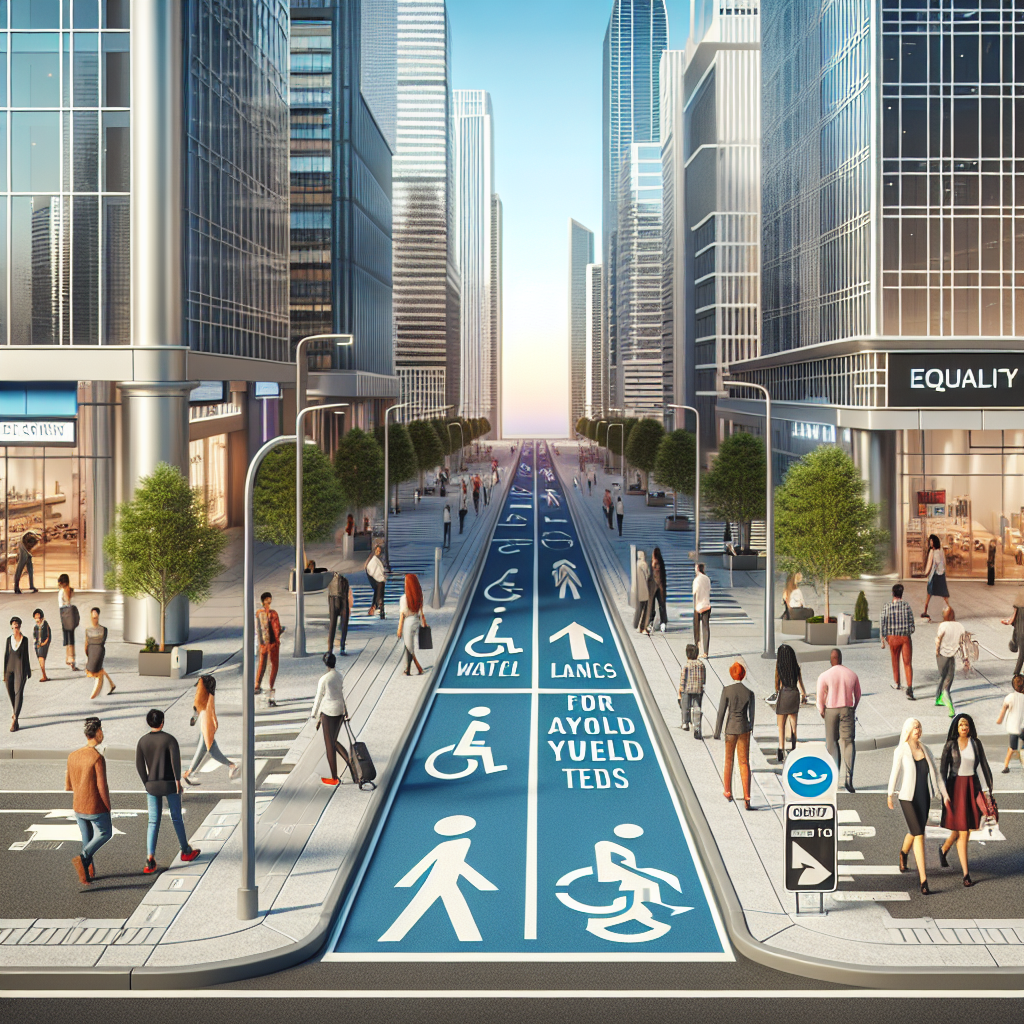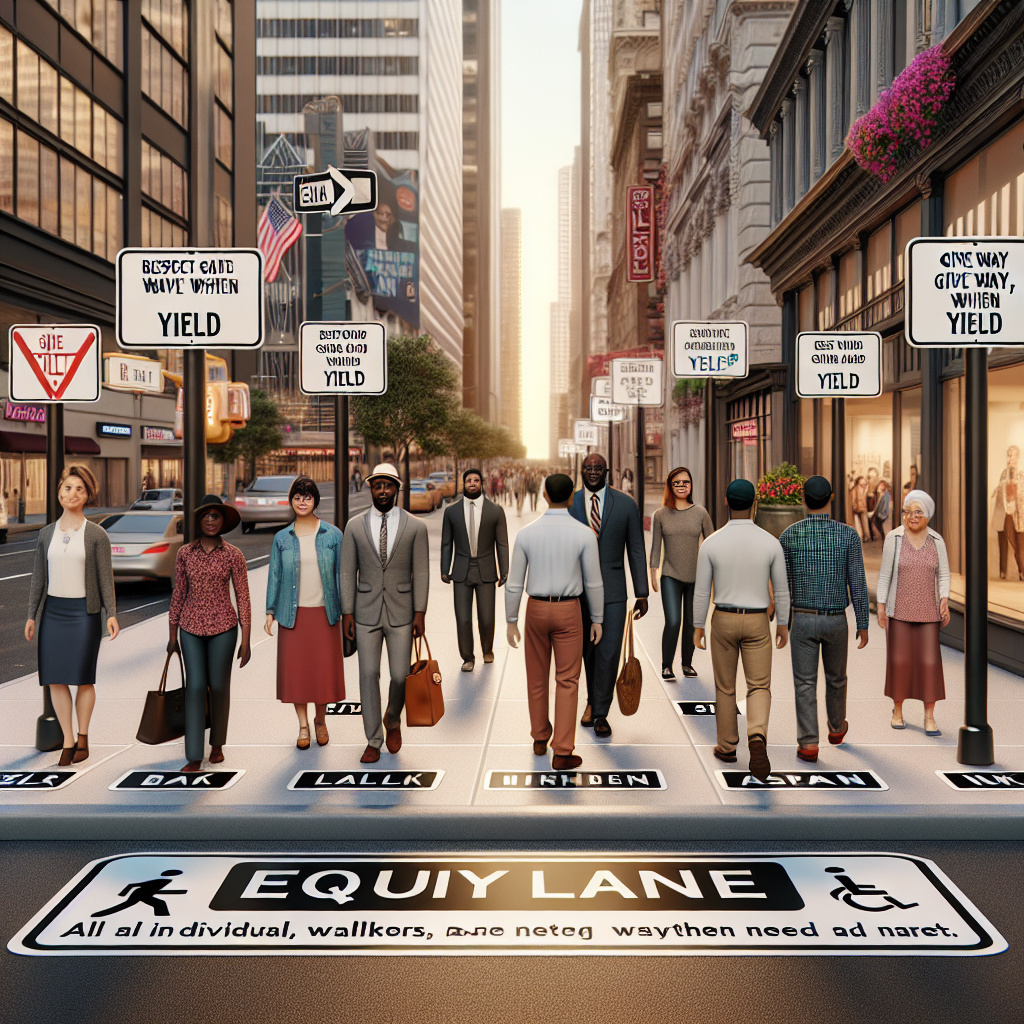Physical Address
304 North Cardinal St.
Dorchester Center, MA 02124
Physical Address
304 North Cardinal St.
Dorchester Center, MA 02124

In an effort to promote equity and inclusivity in public spaces, the city of Portland, Oregon has recently introduced a new concept on its sidewalks – Equity Lanes. These designated lanes are meant to create a more equal and fair experience for pedestrians, particularly for marginalized groups such as people of color, LGBTQ+ individuals, and people with disabilities. This move has sparked both praise and criticism, with some hailing it as a step towards a more just society, while others argue that it is discriminatory towards straight white men.
So, what exactly are Equity Lanes and how do they work on city sidewalks? Essentially, these lanes are designated areas on the sidewalk that are meant to prioritize the safety and comfort of marginalized groups. They are marked with colorful paint or signage and are typically located on wider sidewalks or in areas with high foot traffic. The idea is that these lanes will provide a clear path for those who may face barriers or obstacles on the sidewalk, such as people using wheelchairs or those with strollers.
But how do these lanes actually work? The concept is fairly simple – pedestrians are expected to yield to those using the Equity Lanes. This means that if a person is walking in the Equity Lane, others are expected to move out of the way and allow them to pass without obstruction. This may involve stepping onto the regular sidewalk or moving to the side to create space for the person in the Equity Lane. The goal is to create a more inclusive and respectful environment for all pedestrians, where everyone can move freely and comfortably without feeling marginalized or excluded.
The decision to implement Equity Lanes on city sidewalks was not made lightly. The city conducted extensive research and consulted with various community groups to identify areas where these lanes would be most beneficial. They also took into consideration the concerns of those who may be affected by the new concept, particularly straight white men. Some have argued that these lanes are discriminatory and create a divide between different groups of people. However, proponents of Equity Lanes argue that they are necessary to address the systemic inequalities and barriers that marginalized groups face in public spaces.
One of the main criticisms of Equity Lanes is that they may cause confusion and chaos on the sidewalks. After all, pedestrians are used to walking freely and without any designated lanes. However, the city has taken steps to ensure that the implementation of these lanes is as smooth as possible. They have launched an extensive public education campaign to inform people about the concept and how it works. They have also placed signs and markings on the sidewalks to clearly indicate the presence of Equity Lanes. Additionally, city officials have emphasized that these lanes are not meant to be strictly enforced, but rather to promote a culture of respect and inclusivity on the sidewalks.
While it is still too early to determine the effectiveness of Equity Lanes, many are hopeful that they will create a more equitable and welcoming environment for all pedestrians. The city of Portland is not the first to implement this concept, as other cities such as Seattle and San Francisco have also introduced similar initiatives. It remains to be seen if other cities will follow suit, but one thing is for sure – the introduction of Equity Lanes has sparked an important conversation about equity and inclusivity in public spaces.

In an effort to promote equity and inclusivity in the city, officials have recently introduced a new concept on sidewalks – ‘equity lanes’. These designated lanes are meant to prioritize the safety and comfort of marginalized groups, particularly women, people of color, and members of the LGBTQ+ community. However, one group that may feel the impact of these equity lanes the most is straight white men.
The idea behind equity lanes is to create a space where individuals from marginalized groups can feel safe and free from harassment or discrimination. This is especially important in areas with high foot traffic, such as busy city sidewalks. By designating specific lanes for these groups, it is hoped that they will feel more comfortable and confident navigating the city streets.
But what does this mean for straight white men? For many, it may seem like they are being unfairly targeted or excluded from certain areas. However, it is important to understand the reasoning behind these equity lanes and the impact they can have on all pedestrians.
First and foremost, it is crucial to acknowledge the privilege that straight white men hold in society. They are less likely to face discrimination or harassment based on their gender, race, or sexual orientation. This privilege allows them to move through public spaces without fear or hesitation. On the other hand, marginalized groups often have to navigate these spaces with caution and are more vulnerable to harassment or violence.
By creating equity lanes, the city is acknowledging and addressing this privilege. It is not about excluding straight white men, but rather creating a more equitable and safe environment for all pedestrians. These lanes serve as a reminder that everyone has the right to feel safe and comfortable in public spaces.
Moreover, equity lanes can also benefit straight white men in unexpected ways. By designating specific lanes for marginalized groups, it can help reduce congestion and improve the flow of foot traffic on sidewalks. This can be especially beneficial in busy areas where pedestrians often have to navigate through crowds. With designated lanes, everyone can move more efficiently and safely.
Additionally, these lanes can also serve as a learning opportunity for straight white men. By being aware of and respecting the equity lanes, they can gain a better understanding of the experiences of marginalized groups. It can also encourage them to be more mindful and considerate of others in public spaces.
Of course, there may be some challenges and adjustments that come with the implementation of equity lanes. For example, some may argue that it is difficult to enforce these lanes and ensure that they are being used appropriately. Others may feel inconvenienced by having to navigate around these designated lanes. However, it is important to remember the bigger picture and the positive impact that these lanes can have on marginalized groups.
In conclusion, the introduction of equity lanes on city sidewalks may have a significant impact on straight white men and other pedestrians. While it may initially seem like a form of exclusion, it is important to understand the reasoning behind these lanes and the benefits they can bring to all individuals. By promoting equity and inclusivity in public spaces, the city is taking a step towards creating a more equal and safe environment for everyone.
In an effort to address inequality and promote diversity, the city of New York has recently introduced a new concept on its sidewalks – ‘equity lanes’. These designated lanes are meant to provide a safe and inclusive space for marginalized groups, particularly women and people of color, to navigate the busy city streets.
The idea behind equity lanes is to create a more equitable and fair environment for all pedestrians. It is no secret that cities can be overwhelming and chaotic, with people rushing to get to their destinations and often disregarding the needs of others. This can be especially challenging for those who are already facing discrimination and barriers in their daily lives.
By designating specific lanes for certain groups, the city hopes to promote a sense of inclusivity and respect for all individuals. The concept is similar to bike lanes, which have been successful in promoting safety and accessibility for cyclists. Just as cyclists have their own designated space on the road, equity lanes aim to provide a designated space for those who may feel marginalized on the sidewalks.
But why specifically target straight white men? The answer lies in the fact that they are often the most privileged group in society. As a result, they may not always be aware of the struggles and challenges faced by others. By requiring them to yield in these equity lanes, it serves as a reminder to be mindful and respectful of others who may not have the same privileges.
Some may argue that this is reverse discrimination or that it goes against the principle of equality. However, it is important to understand that equity does not mean treating everyone the same. It means acknowledging and addressing the systemic barriers and inequalities that certain groups face. By creating equity lanes, the city is taking a step towards promoting a more just and fair society.
Moreover, these equity lanes are not meant to exclude straight white men. They are still free to use the other lanes on the sidewalk. The purpose of these lanes is not to create division, but rather to promote awareness and understanding of different perspectives and experiences.
The introduction of equity lanes has been met with both praise and criticism. Some see it as a necessary step towards addressing inequality, while others view it as unnecessary and even discriminatory. However, it is important to note that this is just one small step in a larger effort to promote diversity and inclusivity in our cities.
In addition to equity lanes, the city has also implemented other initiatives to address inequality and promote diversity. This includes diversity training for city employees, increasing representation of marginalized groups in leadership positions, and investing in programs that support underrepresented communities.
It is also worth mentioning that the concept of equity lanes is not unique to New York City. Other cities, such as Portland and San Francisco, have also implemented similar initiatives. This shows that the issue of inequality and the need for promoting diversity is not limited to one city, but rather a widespread concern that needs to be addressed.
In conclusion, the introduction of equity lanes on city sidewalks is a small but significant step towards promoting inclusivity and addressing inequality. By creating designated spaces for marginalized groups, the city is sending a message of respect and understanding for all individuals. While there may be differing opinions on this concept, it is clear that the intention behind it is to create a more just and fair society for all.